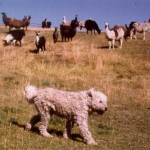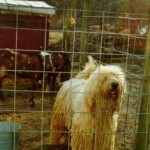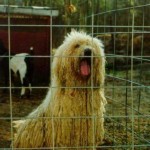THE KOMONDOR AND PREDATOR CONTROL
Prepared by the Predator Control Committee of the Komondor Club of America
 The Komondor is an ancient livestock guarding breed used for centuries on the high plains (Puszta) of Hungary. Similar in size to other European livestock guard dogs, the Komondor is distinguished by its long, corded, adult coat. Because of this coat, it is not easily mistaken for another breed.
The Komondor is an ancient livestock guarding breed used for centuries on the high plains (Puszta) of Hungary. Similar in size to other European livestock guard dogs, the Komondor is distinguished by its long, corded, adult coat. Because of this coat, it is not easily mistaken for another breed.
The Komondor was first brought to the United States in the late 1930’s, but it was not until the late 1960’s that the dogs began to flourish here. Still considered a rare breed, there are 1,000 to 1,500 registered in this country. Because of its rarity, the breed has not been exploited by amateur breeders. Show dogs still have the ability to work, and working dogs are regularly brought into the show ring.
SIZE AND DEMEANOR
The Komondor is a large, sturdy, and imposing animal. A male at maturity is 100 lbs. or more and height at the shoulders is at least 27 1/2 inches. The bitches are 80 lbs. or more and height at least 25 1/2 inches at the shoulder. Both sexes are large and may frighten people not accustomed to dogs. The breed is medium boned and well muscled with a surprising amount of strength. A Komondor should be big and rugged enough to handle difficult working chores in a harsh climate.
TEMPERAMENT

As puppies, the breed is playful, precocious, and a challenge for novice owners. Even puppies raised with livestock cannot be trusted implicitly if housed with young sheep, goats, etc. The owner must supervise introduction of a puppy to livestock as they tend at times to play and chase livestock. As the Komondor matures, it becomes more wary and an effective guard. This maturation may begin at age 6 months, but normally takes place at around 18-24 months. As a general rule, puppies raised with livestock begin to guard earlier than Komondors raised in the house. They also tend to be more aggressive towards strangers than house dogs.
It is very important to socialize the puppies by introducing them to many people and experiences. Obedience training is a good idea for all puppies. If raised on a farm or ranch, the puppies should go into town periodically to meet strangers and friends. Puppies with little human contact can be overly aggressive towards people. As adults, these are the dogs that may bite.
Most times, an older Komondor can be happily retired from outside into the house with no special problems.The breed is very devoted and affectionate to its owners. Komondors are playful and loyal to their family and guard children with special care.
LIVESTOCK GUARDS

An adult Komondor with no particular training will guard what he thinks of as his. With maturity comes the desire to protect the farm or ranch from strangers and predators. The animals, children, adults, buildings and land are considered the Komondor’s territory. It may be difficult to have the dog follow the flock onto pasture because he has left humans and livestock back at the farmstead.
The Komondor needs to be shown his boundaries. It may be easier for owner and dog if boundaries are marked by a fence. It helps to walk a puppy around the borders and verbally reprimand him if he leaves your property. The owner and Komondor must agree upon what is to be guarded. The Komondor will then decide on how to guard it. He may appear lazy and sleepy, but he can easily respond if there is trouble. The breed is amazingly fast and agile and does not need a constant patrol to be effective.
Owners that are most successful have the following attributes; they like dogs and have patience with them, they know what the Komondor’s job is, and they are willing to let the Komondor decide how to do it. They realize that a 10-week-old puppy is not an effective guardian and their predator losses will not stop immediately.The breed responds well to praise. The owner’s voice and displeasure are usually enough to make the dog understand the rules. Some physical correction may be necessary for proper training, but Komondors have been known to bite when owners became heavy-handed.
Not all owners have success with livestock guard dogs. Some will not have success no matter how skilled or willing the dog. Others can take a difficult dog with little initial promise and show great results. Owners must be willing to spend time with a livestock guard dog and ask experienced people questions when they have problems. The dogs are a very effective solution to some predation problems. But they require time, patience, and an understanding of their abilities. At maturity, unless the Komondor has too much territory to cover, predator losses will be substantially reduced if not eliminated.
HEALTH

The Komondor is not subject to any particular health problems. Individual animals may need to be treated by a veterinarian for summer hot-spots or other ailments common to the breed. It’s essential to introduce the puppy to your veterinarian early. In case of emergency, the dog and owner will have an easier time if the Komondor thinks of the veterinarian as a friend. As puppies and adolescents, it is common to have barbed wire cuts as the dogs go over fences. Many times these are severe enough to be stitched.
One health concern of all owners of large dogs is the onset of hip dysplasia. This will become a debilitating problem for the dog and may affect its guarding abilities. The best prevention is to purchase a puppy from a reputable breeder who x-rays his breeding stock and certifies them with the Orthopedic Foundation for Animals (OFA) as being clear of the problem. These breeders will many times give a guarantee against the problem in their puppies. No one can tell just by looking whether adults have hip dysplasia. Breeders must x-ray their dogs.
As with most large breeds, bloat can be a problem in Komondors. The causes are unclear, but bloat is life threatening if it happens. The stomach may fill with air or actually twist itself tight. Owners of all breeds should familiarize themselves with the symptoms. Prompt veterinary care is essential.
Fleas and ticks need to be controlled from the onset of the problem. The dog will scratch out coat if left untreated. This can leave him vulnerable to temperature extremes in harsh winter weather.
Worms are a problem for working dogs. Most veterinarians suggest a regular worming schedule. As with all dogs, they need to be tested and protected against heartworm. There are preventive products that need only be given once a month.
The ear canals fill up with hair and dirt on a Komondor. Owners must take special care that no infection occurs. Regular cleaning of the ears will insure that livestock guards can hear their coyotes or canine adversaries.
COAT
 Unlike any other guard dog, the Komondor develops a matted coat that the owner helps form into cords. As the dog matures, the coat will eventually reach to the ground. This tough and dense coat protects the Komondor from its enemies and shields it from extremes of weather.
Unlike any other guard dog, the Komondor develops a matted coat that the owner helps form into cords. As the dog matures, the coat will eventually reach to the ground. This tough and dense coat protects the Komondor from its enemies and shields it from extremes of weather.
Owners must do some work on the coat as the soft puppy hair forms into mats. The coat is torn by hand down to the skin forming cords the diameter of your thumb. Some coats require much work when the dog is an adolescent, and other dogs are nearly self-cording. Help from someone experienced with the breed is essential when facing this task. When cording is complete, the coat requires little maintenance and will help eliminate hot spots.
PICKING A PUPPY
- Deal with a reputable breeder who will help with questions after the sale.
- Experience with the breed is essential. Breeders with Komondors less than three years old have not dealt with mature dogs.
- Good quality puppies are expensive.
- Ask if the parents’ hips have been x-rayed for hip dysplasia and expect a guarantee on the puppies’ hips.
- Puppies from parents that are not working with livestock will probably still make good working dogs.
- The puppy should have had a series of shots and be vaccinated against parvovirus.

